UMass Extension's Landscape Message is an educational newsletter intended to inform and guide Massachusetts Green Industry professionals in the management of our collective landscape. Detailed reports from scouts and Extension specialists on growing conditions, pest activity, and cultural practices for the management of woody ornamentals, trees, and turf are regular features. The following issue has been updated to provide timely management information and the latest regional news and environmental data.
The Landscape Message will be updated twice in July. The next message will be posted on July 22. To receive immediate notification when the next Landscape Message update is posted, be sure to join our e-mail list
To read individual sections of the message, click on the section headings below to expand the content:
Scouting Information by Region
Environmental Data
The following data was collected on or about July 6, 2022. Total accumulated growing degree days (GDD) represent the heating units above a 50º F baseline temperature collected via regional NEWA stations (http://newa.cornell.edu) for the 2022 calendar year. This information is intended for use as a guide for monitoring the developmental stages of pests in your location and planning management strategies accordingly.
|
MA Region/Location |
GDD |
Soil Temp |
Precipitation |
Time/Date of Readings |
|||||
|
2-Week Gain |
2022 Total |
Sun |
Shade |
||||||
|
CAPE |
283 |
882 |
73 |
67 |
0.91 |
12:00 PM 7/6 |
|||
|
SOUTHEAST |
282 |
993 |
79 |
63 |
0.92 |
3:00 PM 7/6 |
|||
|
NORTH SHORE |
297 |
922 |
70 |
65 |
0.88 |
11:30 AM 7/7 |
|||
|
EAST |
314 |
1092 |
73 |
67 |
1.03 |
5:00 PM 7/6 |
|||
|
METRO |
286 |
1020 |
67 |
64 |
0.98 |
5:30 AM 7/6 |
|||
|
CENTRAL |
292 |
1013 |
78 |
68 |
1.18 |
5:00 PM 7/6 |
|||
|
PIONEER VALLEY |
286.5 |
1042.5 |
70 |
65 |
1.59 |
11:00 AM 7/6 |
|||
|
BERKSHIRES |
233 |
830 |
70 |
65 |
1.92 |
7:45 AM 7/6 |
|||
|
AVERAGE |
284 |
974 |
72.5 |
65.5 |
1.18 |
_ |
|||
|
* = information not available |
|||||||||
As of 7/5, the majority of MA is in "Moderate Drought" status: Massachusetts | U.S. Drought Monitor (unl.edu)
Phenology
| Indicator Plants - Stages of Flowering (BEGIN, BEGIN/FULL, FULL, FULL/END, END) | ||||||||
|---|---|---|---|---|---|---|---|---|
| PLANT NAME (Botanic / Common) | CAPE | S.E. | N.S. | EAST | METRO W. | CENT. | P.V. | BERK. |
|
Buddleia davidii (butterfly bush) |
* |
Full |
Begin/Full |
Begin |
Begin/Full |
* |
Begin |
* |
|
Campsis radicans (trumpet vine) |
Begin |
Full |
Begin |
Begin |
Begin/Full |
* |
Begin/Full |
Begin |
|
Hydrangea paniculata (panicle hydrangea) |
Begin |
Begin |
Begin |
Begin |
Begin/Full |
Begin |
Begin |
* |
|
Koelreuteria paniculata (goldenrain tree) |
Begin |
Begin |
Begin |
Begin |
* |
Begin |
Begin |
* |
|
Lythrum salicaria (loosestrife) |
Begin |
Full |
Begin/Full |
Begin |
Begin/Full |
Begin |
Begin/Full |
Begin |
|
Euonymus alatus (winged euonymus) |
* |
End |
End |
End |
End |
End |
End |
Begin/Full |
|
Rhus typhina (staghorn sumac) |
Full/End |
Full |
Full/End |
Full/End |
Full |
Full |
Full/End |
Begin/Full |
| * = no activity to report/information not available | ||||||||
Regional Notes
Cape Cod Region (Barnstable)
General Conditions: The average temperature for the period from June 22 – July 6 was 70ºF with a low of 50ºF on June 24 and a high of 85ºF on June 25. In general the period was warm with highs in the 70s and low 80s, and nighttime lows primarily in the 60s. The period was dominated by sunny days. Precipitation fell on June 27/28 and July 2 amounting to just under an inch (0.91”). Soil moisture is short; there’s just enough precipitation to keep plants limping along. Some herbaceous plants seen in bloom include rose campion (Lychnis coronaria), tickseed (Coreopsis spp.), shasta daisy (Leucanthemum x superbum), daylily (Hemerocallis spp.), butterflyweed (Asclepias tuberosa), red hot poker (Kniphofia uvaria), montbretia (Crocosmia x crocosmiiflora), blazing star (Liatris spicata), purple coneflower (Echinacea purpurea), Japanese mountain lily (Lilium auratum) and plantain lily (Hosta spp.). Some woody plants seen in bloom include Kousa dogwood (Cornus kousa), roses (Rosa spp.), hydrangeas (Hydrangea spp.), New Jersey tea (Ceanothus americanus), elderberry (Sambucus canadensis), Japanese meadowsweet (Spiraea japonica), and privet (Ligustrum ovalifolium).
Pests/Problems: Japanese, Oriental and Asiatic beetles are active, roseslug sawfly damage was observed on rose, viburnum leaf beetle damage on viburnum, leaf miner damage on daylily, four lined plant bug damage on shasta daisy and viburnum, hibiscus sawfly damage on hardy hibiscus and turpentine beetle activity on pitch pine. Earwig, slug and snail damage were seen on herbaceous perennials. Disease symptoms observed during the period include branch dieback and tip dieback on Leyland cypress, powdery mildew on phlox, asters, viburnum, and burning bush, brown rot on ornamental cherry, black spot on rose, and anthracnose on river birch. Ticks are everywhere – keep yourself protected.
Southeast Region (Dighton)
General Conditions: The weather over the past two week reporting period has been warm and dry. Day temperatures have ranged into the nineties while nights have been mostly in the fifties. We reached the day time highs of 90°F and 91°F on June 25th and 26th. The lowest night time reading was 48°F on June 24. Cooler temperatures arrived Monday, 6/27 and brought 0.89 inches of much needed rain. Plants seen in flower include: Achillea millefolium (yarrow), Alchemilla mollis (lady's mantle), Asclepias incarnata (swamp milkweed), A. syriaca (common milkweed), Aesculus parviflora (bottlebrush buckeye), Castanea sativa (sweet chestnut), Cephalanthus occidentalis (button bush), Cichorium intybus (chicory), Coreopsis verticillata (tickseed), Dacus carota (Queen Anne's lace), Dasiphora fruticosa (shrubby cinquefoil), Echinacea spp. (coneflower), Eutrochium purpureum (joe-pye-weed), Gaillardia arista (blanket flower), Hypericum perforatum (St. John's-wort), Lavandula angustifolia (lavender), Linaria vulgaris (yellow toadflax), Lotus coniculatus (bird’s-foot trefoil), Lysimachia ciliata (fringed loosestrife), L. clethroides (gooseneck loosestrife), Monarda spp. (beebalm), Nymphaea odorata (water lily), Opuntia humisifolia (eastern prickly-pear cactus), Phlox paniculata (garden phlox), Pilosella caespitosa (yellow hawkweed), Rhododendron viscosum (swamp azalea), Rudbeckia hirta (black-eyed-susan), Salvia yangii (Russian sage), Sambucus canadensis (elderberry), Silybum marianum (milk thistle), Spiraea alba (meadowsweet), Stewartia pseudocamellia (deciduous camellia), Tamarix ramosissima (salt cedar), Thalictrum spp. (meadow rue), Trifolium repens (white clover), Typha sp. (cattail), Verbascum thapsus (great mullein), and Yucca filamentosa (Adam's needle and thread).
Pests/Problems: Drought remains a serious problem especially now that we are in the summer season with higher temperatures expected. Occasional LDD (Lymantria dispar dispar) males have been about doing their typical, waist height, frantic search for females. Ash rust has been causing leaf fall on infected trees. Crabgrass has four or more tillers. Woe to the gardener who has planted the invasive Campanula rapunculoides (creeping bellflower). Calystegia sepium (hedge bindweed) and yellow nutsedge are very obvious where present.
North Shore (Beverly)
General Conditions: This reporting period saw the end of June and the first week of July. The last half of the month of June was unusually dry with only 0.92 inches of rain recorded at Long Hill during the last three weeks of June. The total rainfall for the month of June at Long Hill was 2.46 inches. According to the US drought monitor the region is in moderate drought. Grass on non-irrigated lawns that are exposed to full sun are starting to turn brown due to moisture stress. The weather conditions during this period were mostly hot and humid with partial sunlight and overcast skies. Day temperatures ranged from mid 70s to mid 80s and night temperatures ranged from mid 50s to mid 60s. The average daily temperature for this period was 71℉ with the maximum temperature of 90℉ recorded on July 1 and the minimum temperature of 55℉ recorded on June 28. Woody plants seen in bloom include: Virginia sweetspire (Itea virginica), sweet azalea (Rhododendron arborescens), indigo (Indigofera amblyantha), oakleaf hydrangea (Hydrangea quercifolia), big leaf hydrangea (Hydrangea macrophylla), smooth leaf hydrangea (Hydrangea arborescens), summer blooming spirea (Spiraea japonica), ‘Winterthur’ smooth witherod (Viburnum nudum), and kousa dogwood (Cornus kousa). Herbaceous plants seen in bloom include: summer flowering roses (Rosa spp.), clematis vines (Clematis paniculata), foxglove (Digitalis purpurea), goat’s beard (Aruncus dioicus), ox-eye daisy (Leucanthemum vulgare), shasta daisy (Leucanthemum x superbum), yarrow (Achillea spp.), catmint (Nepeta cataria), snakeroot (Actaea spp.), daylilies (Hemerocallis spp.), hostas, astilbes, montbretia (Crocosmia ‘Lucifer’) and an assortment of annuals.
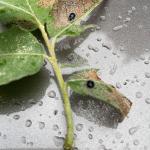 Pests/Problems: Imported willow leaf beetle (Plagiodera versicolora) was observed causing damage on pussy willow (Salix caprea) leaves. They are small dark metallic blue beetles (1/8" long). Adults and larvae feed on the leaves of willow. Bacillus thuringiensis var. san diego, horticultural oil, and spinosad can be used to control the beetles. (See more about IWLB in the Insect Report below.) Deer browsing continues to be observed on hosta and some of the shrubs. Turf on droughty and exposed lawns is showing drought stress and needs more rain to start growing again. Remember that ticks and mosquitoes are still very active. Take measures to protect yourself while working outdoors, especially at dawn or dusk. If you find a tick on yourself or on your dog consider submitting it by mail to a commercial lab that provides testing of ticks for common pathogens. For a list of available tick testing labs go to: https://ag.umass.edu/resources/tick-testing-resources
Pests/Problems: Imported willow leaf beetle (Plagiodera versicolora) was observed causing damage on pussy willow (Salix caprea) leaves. They are small dark metallic blue beetles (1/8" long). Adults and larvae feed on the leaves of willow. Bacillus thuringiensis var. san diego, horticultural oil, and spinosad can be used to control the beetles. (See more about IWLB in the Insect Report below.) Deer browsing continues to be observed on hosta and some of the shrubs. Turf on droughty and exposed lawns is showing drought stress and needs more rain to start growing again. Remember that ticks and mosquitoes are still very active. Take measures to protect yourself while working outdoors, especially at dawn or dusk. If you find a tick on yourself or on your dog consider submitting it by mail to a commercial lab that provides testing of ticks for common pathogens. For a list of available tick testing labs go to: https://ag.umass.edu/resources/tick-testing-resources
East Region (Boston)
General Conditions: We have experienced spectacular summer weather over the past two weeks. Daytime temperatures averaged 83ºF, reaching 93ºF on June 26 and 90ºF on July 1. We accumulated 1.03” of precipitation, including a beneficial soaking of 0.67 inches on June 27. The landscape is an abundance of color as many pollinator friendly perennial borders are coming into full bloom. The underutilized native Calycanthus floridus (Carolina allspice) is in bloom. Among its many fine qualities are resistance to deer, disease and insect damage. in addition to fine fragrance, butterflies, bees and beetles enjoy its nectar. 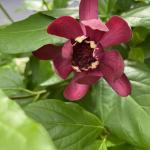
Pests/Problems: Dry soils continue to be a concern despite the 1.03” of precipitation we received over the past two weeks. Prior to the 0.67 inch soaking on June 27, we were in a 1.65 inch deficit for an average June and 5.9 inches below average for 2022. Unirrigated turf has begun to go dormant. Containers, vegetable gardens and recent transplants require supplemental irrigation. In late June an outbreak of fire blight was observed on many Rosaceous plants, Malus spp. (crabapple) in particular, also on Prunus spp. (cherry and peach). Cedar apple rust has been observed on some Amelanchier spp. (serviceberry) fruit. Powdery mildew is present on Cornus spp. (dogwood), Paeonia spp. (peony) and Syringa spp. (lilac). Hibiscus sawfly slugs have been busy carving up hardy hibiscus foliage. Mosquitoes and ticks are out in abundance throughout the landscape.
Metro West (Acton)
General Conditions: Summer has arrived and we’ve experienced a few 90°F days to prove it on June 25th and 26th and then again on July 1st. For June, the historical monthly average for precipitation is 3.93” and just 2.21” of rain was recorded, another month with below average rainfall. For July, the monthly average for precipitation is 3.95” and as of the 5th, a mere 0.35” of rain has been recorded. Observed in some stage of bloom this past week were the following woody plants: Castanea mollissima (Chinese chestnut), Hydrangea arborescens (smooth hydrangea), H. quercifolia (oakleaf hydrangea), Oxydendrum arboreum (sourwood), Potentilla fruticosa (potentilla), Rhododendron viscosum (swamp azalea), Sambucus canadensis (elderberry), Spiraea japonica 'Alpina' (daphne spirea), and Stewartia pseudocamellia (Japanese stewartia). Contributing even more color and interest to the landscape are some flowering herbaceous plants including: Alcea rosea (hollyhock), Asclepias syriaca (common milkweed), A. tuberosa (butterfly weed), Astilbe spp. (false spirea), Campanula takesimana ‘Elizabeth’ (bell flower), Coreopsis sp. (tickseed), C. verticillata (threadleaf coreopsis), Daucus carota (Queen Anne's lace), Echinacea purpurea (coneflower), Gaillardia aristata (blanket flower), Hemerocallis fulva (orange daylily), Heuchera spp. (coral bells), Hosta spp. (plantain lily), Lavendula angustifolia (lavender), Leucanthemum x superbum (shasta daisy), Liatris spicata (spike gayfeather), Lilium spp. (lily), Lychnis coronaria (rose campion), Lysimachia clethroides (gooseneck loosestrife), Monarda didyma (scarlet beebalm), Oenothera macrocarpa (Ozark sundrops), Rudbeckia hirta (black-eyed Susan), Stachys byzantina (lamb’s ear), Thymus praecox (thyme) and Yucca filamentosa (yucca).
Pests/Problems: The lack of any substantial and steady rain continues to be a concern for our trees and shrubs. Despite the recent rain, recorded precipitation is well below average levels and this has been the case for the months of March, April, May, and June. Signs of stress are apparent on trees and shrubs with premature leaf drop, leaf discoloration, and flagging. (See the drought monitor link below the environmental data table above.)
Central Region (Boylston)
General Conditions: The early days of summer have been relatively pleasant, with a handful of seasonal 90°F days, but very comfortable overnight temperatures for the most part. Fortunately, the cooler temperatures at this time of year are helping to offset the lack of substantial precipitation. There is still plenty in bloom across the garden, including some fantastic ornamentals. Ramps (Allium tricoccum), a native onion species typically associated with spring when its tasty edible foliage emerges, is now coming into bloom. Other interesting native plants observed in flower this week include prickly pear (Opuntia humifusa), a cactus found in coastal areas throughout New England, with beautiful yellow flowers followed by edible fruit, milkweeds (Asclepias tuberosa, A. syriaca, and A. incarnata) and Nymphaea odorata (white water lily).
Pests/Problems: Ticks and mosquitoes are quite active, as is to be expected this time of year. Again, the biggest concern this reporting period is drought. Unirrigated lawns are browning and going dormant, poorly sited trees and shrubs that are not watered regularly are flagging and dropping foliage as the entire Central region has now moved into moderate drought. With less than 2.5 inches of precipitation for June, hopefully we will see some significant rainfall in July to make up for the water deficit we’re facing now.
Pioneer Valley Region (Amherst)
General Conditions: July has arrived as we settle into mid-summer in the Pioneer Valley. Conditions over the past two weeks ranged from pleasant to hot and while the valley has received some scattered rain, it certainly has not been enough to make up for the accruing deficit. At the Easthampton gauge, ~1.6” of rainfall was recorded on 6/27, 7/1 and 7/5, but accumulations across the tri-counties since our last report vary dramatically. Once again, there is no substitute for a good rain gauge and this can help guide supplemental irrigation. This time of year, rainfall is all about the “haves” and the “have nots”. Passing thunderstorms may soak an area while a few miles away it remains bone dry. According to the Northeast Regional Climate Center, June was both cooler and drier than average. The cooler conditions were most welcome, given the blazing heat we experienced during June 2020 and 2021. The dry conditions are not welcome and nearly all of the tri-counties are now in the “moderate drought” (D2) classification, based on the U.S. Drought Monitor. As of 6/23, four towns across the tri-counties (Shelburne, Northampton, Easthampton and Southwick) have non-essential outdoor water use restrictions in place (see map here).
Pests/Problems: By mid-July, some important wood-rotting pathogens of landscape and forest trees will start producing their annual fruiting bodies. This list includes, but is not limited to, chicken of the woods (Laetiporus sulphureus and L. cincinnatus) and Berkeley’s polypore (Bondarzewia berkeleyi). Clusters of fleshy, shelf-like fruiting bodies may form on roots several feet away from the tree, directly next to the base of the trunk, or on the trunk itself. Be mindful of their emergence and location. When numerous fruiting bodies develop around the base of a tree, it’s often a good indication that serious root decay is present. Lacebug (Stephanitis sp.) damage was observed on azaleas and now is a good time to scout rhododendrons, azaleas and andromedas for symptoms and signs of infestations. The upper leaf surface will exhibit flecking symptoms and dark-colored lacebugs and frass will be visible on the leaf underside. Insecticidal soap is effective for controlling lacebugs but apply when humidity levels are low and repeated applications may be required to thoroughly coat the underside of the foliage. Foliar damage on perennial hibiscus caused by Hibiscus sawfly larvae (Atomacera decepta) was also found. Bagworms can be seen in the canopies of eastern redcedar and blue spruce around the region. The iridescent green June beetle (Cotinis nitida) was observed (and heard) recently. These large (up to ¾” long) scarab beetles buzz loudly as they chaotically fly around the landscape. Their flight pattern often takes them straight into trees, homes, and other outdoor obstacles at full speed with a loud bang. It is hard to observe these insects without thinking that evolution favored body size over brain development. White pines have mostly shed all of their older, diseased needles. But some diseased needles remain trapped in the canopy, providing inoculum to infect the current season’s growth.
Berkshire Region (Great Barrington)
General Conditions: After a bit of heat at the beginning of this scouting period, temperatures have moderated quite a bit and for much of the past week the daily highs and lows have been below the norm. The highest temperatures for the two week scouting stretch were: 93ºF on 6/25 and 6/26 at North Adams airport; 86ºF on 6/26 and 7/1 at Pittsfield Airport; and 88ºF on 6/26 in Richmond. Lowest temperatures were: 51ᣞF on 7/4 at North Adams; 49ᣞF on 6/29 at Pittsfield; and 46ᣞF on 6/29 in Richmond. The mean temperatures for the period were 70.6ᣞF for North Adams, 66.2ºF for Pittsfield, and 66.5ºF for Richmond. Rainfall amounts were: 1.57 inches in North Adams, 1.59 inches in Pittsfield, 1.43 inches in Richmond, and 1.92 inches at this West Stockbridge site. The cooler temperatures have made outdoor work more tolerable and were much welcomed. The forecast ahead is for a continuation of the below normal temperatures. Rainfall totals for the year, as reported at the Pittsfield Airport are just about at the normal for year-to-date. As such, soil moisture levels are very good, i.e. not saturated and not moisture deficient. Plant growth has responded well to the mild temperatures and soil moisture levels. The flowering period for many perennials and woody species has been somewhat extended beyond what is typical. Growth of turfgrass has been steady and lawns are lush.
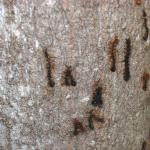 Pests/Problems: The combination of moisture and warmth has prompted an increase in the mosquito population. Deer ticks and dog ticks are prominent as are various gnats. An insect that has recently made its appearance and is frightening many folks, despite being relatively harmless, is the great golden digger wasp. The pest which has garnered the most attention in many parts of the Berkshires is the spongy moth caterpillars. Their numbers and the amount of defoliation they caused were immense. There are still some of the caterpillars feeding but their numbers are rapidly decreasing. Some have pupated and both male and stationary female moths were observed this week. However, the largest decline in numbers has been due to infection by either the fungus Entomophaga maimaiga or by the NPV virus (See the Insect section of this Landscape Message for more photos.) While the spongy moth is declining, Japanese beetles appeared during the last week of June and their numbers are steadily increasing. Other pests observed this week were: lily leaf beetle adults, imported willow leaf beetle adults, hemlock woolly adelgid, and aphids. Plant diseases were few, mostly foliar leaf spots. Voles and chipmunks are plentiful and are digging holes in gardens and lawns.
Pests/Problems: The combination of moisture and warmth has prompted an increase in the mosquito population. Deer ticks and dog ticks are prominent as are various gnats. An insect that has recently made its appearance and is frightening many folks, despite being relatively harmless, is the great golden digger wasp. The pest which has garnered the most attention in many parts of the Berkshires is the spongy moth caterpillars. Their numbers and the amount of defoliation they caused were immense. There are still some of the caterpillars feeding but their numbers are rapidly decreasing. Some have pupated and both male and stationary female moths were observed this week. However, the largest decline in numbers has been due to infection by either the fungus Entomophaga maimaiga or by the NPV virus (See the Insect section of this Landscape Message for more photos.) While the spongy moth is declining, Japanese beetles appeared during the last week of June and their numbers are steadily increasing. Other pests observed this week were: lily leaf beetle adults, imported willow leaf beetle adults, hemlock woolly adelgid, and aphids. Plant diseases were few, mostly foliar leaf spots. Voles and chipmunks are plentiful and are digging holes in gardens and lawns.
Regional Scouting Credits
- CAPE COD REGION - Russell Norton, Horticulture and Agriculture Educator with Cape Cod Cooperative Extension, reporting from Barnstable.
- SOUTHEAST REGION - Brian McMahon, Arborist, reporting from the Dighton area.
- NORTH SHORE REGION - Geoffrey Njue, Green Industry Specialist, UMass Extension, reporting from the Long Hill Reservation, Beverly.
- EAST REGION - Kit Ganshaw & Sue Pfeiffer, Horticulturists reporting from the Boston area.
- METRO WEST REGION – Julie Coop, Forester, Massachusetts Department of Conservation & Recreation, reporting from Acton.
- CENTRAL REGION - Mark Richardson, Director of Horticulture reporting from New England Botanic Garden at Tower Hill, Boylston.
- PIONEER VALLEY REGION - Nick Brazee, Plant Pathologist, UMass Extension Plant Diagnostic Lab, reporting from Amherst.
- BERKSHIRE REGION - Ron Kujawski, Horticultural Consultant, reporting from Great Barrington.
Woody Ornamentals
Diseases
Recent pests and pathogens of interest seen in the UMass Extension Plant Diagnostic Lab, a select few:
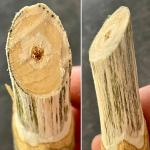 Verticillium wilt of sugar maple (Acer saccharum) and red maple (Acer rubrum ‘Red Sunset’) caused by Verticillium dahliae. The sugar maple is approximately 10- to 12-years-old and resides in full sun with well-drained soils. Soil testing revealed a pH of 5.8 with high levels of iron and manganese. The tree was transplanted from one location to another on a residential property in late November of 2021. An irrigation system that provides supplemental water has been inoperable this season. In recent weeks, flagging developed in a large canopy branch. Specific symptoms included browning, curling and shedding leaves. Shaving of the bark revealed very conspicuous vascular staining caused by Verticillium (see photo). It is possible the tree was resisting infection prior to being moved. The shock of transplanting and lack of supplemental irrigation could have allowed the disease to overcome the tree’s defenses. The red maple is also approximately 12-years-old. This tree was transplanted four years ago at a site with sandy/gravelly soils and full sun. It was watered only sparingly the first year in the ground and no supplemental water has been provided since. The managing arborist noted less than 1” of annual growth over the past three years, indicating quite clearly that the tree is struggling. The foliage appears stunted and undersized and there is lower branch dieback. Removal of the bark once again revealed green-colored vascular staining that consumed ~15% of the stem circumference.
Verticillium wilt of sugar maple (Acer saccharum) and red maple (Acer rubrum ‘Red Sunset’) caused by Verticillium dahliae. The sugar maple is approximately 10- to 12-years-old and resides in full sun with well-drained soils. Soil testing revealed a pH of 5.8 with high levels of iron and manganese. The tree was transplanted from one location to another on a residential property in late November of 2021. An irrigation system that provides supplemental water has been inoperable this season. In recent weeks, flagging developed in a large canopy branch. Specific symptoms included browning, curling and shedding leaves. Shaving of the bark revealed very conspicuous vascular staining caused by Verticillium (see photo). It is possible the tree was resisting infection prior to being moved. The shock of transplanting and lack of supplemental irrigation could have allowed the disease to overcome the tree’s defenses. The red maple is also approximately 12-years-old. This tree was transplanted four years ago at a site with sandy/gravelly soils and full sun. It was watered only sparingly the first year in the ground and no supplemental water has been provided since. The managing arborist noted less than 1” of annual growth over the past three years, indicating quite clearly that the tree is struggling. The foliage appears stunted and undersized and there is lower branch dieback. Removal of the bark once again revealed green-colored vascular staining that consumed ~15% of the stem circumference.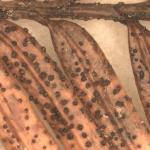 Dieback of yew (Taxus sp.) caused by edema, an infestation of the cottony Taxus scale (Pulvinaria floccifera) and Cryptocline needle blight (Cryptocline taxicola). Large and old plants in a shaded setting with browning and yellowing of older needles that was observed in the spring. Cryptocline needle blight is one of the few diseases of significance on yews. The fungus attacks the foliage and may spread to nearby stems, and infected plants often have brown needles that may prematurely shed or hang in the canopy. The fungus produces black-colored, spore-bearing pads that rupture the epidermis to release spores (see photo). The lab has received many yew samples this year with yellowing/browning needles that are prematurely shedding. In some cases, edema appears to be partly to blame. Last year’s record-setting precipitation created persistently wet soils that are stressful for yews. Shedding of large volumes of older needles could be in response to these wet soil conditions in 2021.
Dieback of yew (Taxus sp.) caused by edema, an infestation of the cottony Taxus scale (Pulvinaria floccifera) and Cryptocline needle blight (Cryptocline taxicola). Large and old plants in a shaded setting with browning and yellowing of older needles that was observed in the spring. Cryptocline needle blight is one of the few diseases of significance on yews. The fungus attacks the foliage and may spread to nearby stems, and infected plants often have brown needles that may prematurely shed or hang in the canopy. The fungus produces black-colored, spore-bearing pads that rupture the epidermis to release spores (see photo). The lab has received many yew samples this year with yellowing/browning needles that are prematurely shedding. In some cases, edema appears to be partly to blame. Last year’s record-setting precipitation created persistently wet soils that are stressful for yews. Shedding of large volumes of older needles could be in response to these wet soil conditions in 2021.- Dutch elm disease, caused by Ophiostoma novo-ulmi, on Valley Forge American elm (Ulmus americana ‘Valley Forge’) and slippery elm (U. rubra). The Valley Forge elm is around 10-years-old and resides in sandy, well-drained soils with full sun. The tree was cabled this past winter, as Valley Forge are often prone to wind-induced branch failure. Valley Forge has been repeatedly shown to be one of the most DED-resistant American elm cultivars. However, flagging and dieback in the lower canopy developed in early June and the pathogen was identified from submitted branch segments. The slippery elms (six in total) are ~20- to 30-years-old and were planted in a thin median strip between a parking lot and road surrounded by turfgrass. In early to mid-June, the trees exhibited moderate to severe canopy dieback, with browning and shedding leaves throughout the canopies. The trees were injected with Arbotect 20-S in 2016, but have not received any fungicidal injections since that time. Based on their current appearance, most are unlikely to survive the year.
- Phomopsis cankering of Japanese maple (Acer palmatum). Trees ranging in age from ~5-years-old to >20-years-old. Site conditions range from shaded to full sun and varying levels of irrigation (none, lawn sprinklers and drip). Scattered branch dieback was visible in all the trees with brown and curling leaves in some cases. On some stems, dark-colored lesions and cracking/splitting bark was present. Phomopsis is very common on Japanese maples and when these trees are stressed by drought or winter injury, the fungus can spread rapidly, killing small stems and large branches. Japanese maples should be scouted regularly for any dead stems and branches, especially on interior portions of the canopy. These dead parts should be pruned out to reduce any inoculum that could ignite a disease outbreak should abiotic stress develop.
- Fire blight of apple/crabapple (Malus spp.) caused by the bacterium Erwinia amylovora. Trees ranging in age from <10-years-old to >80-years-old. Symptoms of the disease include blackened shoots and leaves scattered through the canopy. The terminal shoot becomes curled downward, forming a “Shepherd's crook”. Large volumes of bacterial streaming can be observed microscopically from the outer stem vascular tissue and leaf petioles. The trees all developed noticeable symptoms in early June. Many fire blight infections occur when trees are in bloom in mid-May but symptoms may take a few weeks to become apparent. While the site settings for each diseased tree vary, local weather conditions largely determine if an outbreak will occur. Rain events and mild temperatures during the blooming period readily facilitate spread and disease development.
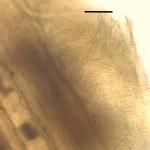
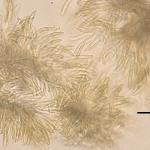 Brown needle spot (Lecanosticta acicola) on eastern white pine (Pinus strobus) and another five-needle pine (either P. koraiensis or P. flexilis). Both trees are approximately 20-years-old and receive a mixture of sun and shade. Older needles (2021) turned brown to straw-colored and were prematurely shedding from the canopy in early to mid-June. Trees that have chronic issues with white pine needle blight typically do not have any needles older than one year. As the current season’s growth elongates (i.e. the 2022 needles), nearly all of the older needles (2021) are prematurely shed from the canopy. Lecanosticta was forced to sporulate from straw-colored needles after a brief incubation (see photos).
Brown needle spot (Lecanosticta acicola) on eastern white pine (Pinus strobus) and another five-needle pine (either P. koraiensis or P. flexilis). Both trees are approximately 20-years-old and receive a mixture of sun and shade. Older needles (2021) turned brown to straw-colored and were prematurely shedding from the canopy in early to mid-June. Trees that have chronic issues with white pine needle blight typically do not have any needles older than one year. As the current season’s growth elongates (i.e. the 2022 needles), nearly all of the older needles (2021) are prematurely shed from the canopy. Lecanosticta was forced to sporulate from straw-colored needles after a brief incubation (see photos).
Report by Nick Brazee, Plant Pathologist, UMass Extension Plant Diagnostic Lab, UMass Amherst.
Insects
An Update about Neonicotinoid Use in Massachusetts:
Beginning July 1, 2022 systemic insecticide active ingredients known as neonicotinoids have become state restricted use for tree and shrub uses in Massachusetts. If an individual works in the commercial industry (landscapers, arborists, etc.), then a Commercial Certification License is needed. (Example: Category 36 Commercial Certification License, Shade Trees & Ornamentals.) Someone can use a state or federal restricted use pesticide if they have a Commercial Applicators License as long as they are working under the direct supervision of someone with a Commercial Certification. Unlicensed or uncertified individuals will no longer be able to apply neonicotinoids to manage insect pests of trees and shrubs in Massachusetts.
More information is available, here: https://www.mass.gov/service-details/pesticide-newsupdates
Helpful Information from Taryn LaScola-Miner, Director, Crop and Pest Services Division of the MA Department of Agricultural Resources:
“As you know, products that contain neonicotinoids and have certain use patterns will have a classification change from General Use to Restricted Use on July 1, 2022. In order to help inform the manufacturers, dealers, sellers and applicators of which products will be changing from general use to restricted use, the Department has created the list of neonicotinoid products that currently are and will become restricted use beginning July 1st. You may find the list at the link below. Please note that this list is subject to change.
Additionally, MDAR is anticipating that there will be more of a need for companies to follow the Direct Supervision regulations with this change. Therefore, MDAR has updated its Direct Supervision Frequently Asked Questions document as well.
Although an email will be sent to all licensed applicators within the next few weeks as a final reminder of the change, please pass this information along to your members and customers as an effort to make this transition as smooth as possible. If you have any questions, please let me know. Thank you!”
List of Neonicotinoid Products: https://www.mass.gov/doc/list-of-neonicotinoid-pesticides/download
Direct Supervision Frequently Asked Questions: https://www.mass.gov/doc/direct-supervision-frequently-asked-questions-faq/download
Interesting Insects Reported Recently:
 Assassin Bugs: Hemiptera: Reduviidae: this family of true bugs are known as the assassin bugs. As their name might suggest, they are predators. They feed on the immatures and adults of other insect species, including at times other assassin bugs. These insects are often elongated, thin, and have pronounced, long mouthparts used to pierce their prey. Some possess spines, and others have a “wheel” on their back which might look to some like half of a saw blade sunk into their thorax. While assassin bugs can be important predators of pest insects, they alone may not become abundant enough to manage entire pest populations. That said, it is important to recognize them, as well as their egg masses and immatures, as beneficial insects and to seek to preserve their numbers when making management decisions. This assassin bug egg mass and first instar nymphs were seen on blueberry in Hampshire County on 7/5/2022.
Assassin Bugs: Hemiptera: Reduviidae: this family of true bugs are known as the assassin bugs. As their name might suggest, they are predators. They feed on the immatures and adults of other insect species, including at times other assassin bugs. These insects are often elongated, thin, and have pronounced, long mouthparts used to pierce their prey. Some possess spines, and others have a “wheel” on their back which might look to some like half of a saw blade sunk into their thorax. While assassin bugs can be important predators of pest insects, they alone may not become abundant enough to manage entire pest populations. That said, it is important to recognize them, as well as their egg masses and immatures, as beneficial insects and to seek to preserve their numbers when making management decisions. This assassin bug egg mass and first instar nymphs were seen on blueberry in Hampshire County on 7/5/2022.
Insects and Other Arthropods
-
Deer Tick/Blacklegged Tick: Ixodes scapularis adults are active all winter and spring, as they typically are from October through May, and “quest” or search for hosts at any point when daytime temperatures are above freezing. Engorged females survive the winter and will lay 1,500+ eggs in the forest leaf litter beginning around Memorial Day (late May). Larval and nymphal deer ticks may be encountered at this time. Larvae are encountered in New England from roughly May through November, with peak risk reported in August. Nymphs are encountered from April through July with a peak risk reported in June in New England. Nymphs may also be encountered again in October and November. For images of all deer tick life stages, along with an outline of the diseases they carry, visit: https://web.uri.edu/tickencounter/species/blacklegged-tick/ .
Anyone working in the yard and garden should be aware that there is the potential to encounter deer ticks. The deer tick or blacklegged tick can transmit Lyme disease, human babesiosis, human anaplasmosis, and other diseases. Preventative activities, such as daily tick checks, wearing appropriate clothing, and permethrin treatments for clothing (according to label instructions) can aid in reducing the risk that a tick will become attached to your body. If a tick cannot attach and feed, it will not transmit disease. For more information about personal protective measures, visit: https://web.uri.edu/tickencounter/prevention/protect-yourself/
The Center for Agriculture, Food, and the Environment provides a list of potential tick identification and testing resources here: https://ag.umass.edu/resources/tick-testing-resources .
-
Mosquitoes: According to the Massachusetts Bureau of Infectious Disease and Laboratory Science and the Department of Public Health, there are at least 51 different species of mosquito found in Massachusetts. Mosquitoes belong to the Order Diptera (true flies) and the Family Culicidae (mosquitoes). As such, they undergo complete metamorphosis, and possess four major life stages: egg, larva, pupa, and adult. Adult mosquitoes are the only stage that flies and many female mosquitoes only live for 2 weeks (although the life cycle and timing will depend upon the species). Only female mosquitoes bite to take a blood meal, and this is so they can make eggs. Mosquitoes need water to lay their eggs in, so they are often found in wet or damp locations and around plants. Different species prefer different habitats. It is possible to be bitten by a mosquito at any time of the day, and again timing depends upon the species. Many are particularly active from just before dusk, through the night, and until dawn. Mosquito bites are not only itchy and annoying, but they can be associated with greater health risks. Certain mosquitoes vector pathogens that cause diseases such as West Nile virus (WNV) and eastern equine encephalitis (EEE). For local risk levels of WNV and EEE based on state sampling, visit: https://www.mass.gov/info-details/massachusetts-arbovirus-update .
For more information about mosquitoes in Massachusetts, visit: https://www.mass.gov/service-details/mosquitoes-in-massachusetts
There are ways to protect yourself against mosquitoes, including wearing long-sleeved shirts and long pants, keeping mosquitoes outside by using tight-fitting window and door screens, and using insect repellents as directed. Products containing the active ingredients DEET, permethrin, IR3535, picaridin, and oil of lemon eucalyptus provide protection against mosquitoes. Be aware that not all of these can be safely used on young children. Read and follow all label instructions for safety and proper use.
For more information about mosquito repellents, visit: https://www.mass.gov/service-details/mosquito-repellents and https://www.cdc.gov/mosquitoes/mosquito-bites/prevent-mosquito-bites.html
-
Wasps/Hornets: Many wasps are predators of other arthropods, including pest insects such as certain caterpillars that feed on trees and shrubs. Adult wasps hunt prey and bring it back to their nest where young are being reared, as food for the immature wasps. A common such example are the paper wasps (Polistes spp.) who rear their young on chewed up insects. They may be seen searching plants for caterpillars and other soft-bodied larvae to feed their young. Paper wasps can sting, and will defend their nests, which are open-celled paper nests that are not covered with a papery “envelope”. These open-celled nests may be seen hanging from eaves or other outdoor building structures. Aerial yellow jackets and hornets create large aerial nests that are covered with a papery shell or “envelope”. Common yellow jacket species include those in the genus Vespula. Dolichovespula maculata is commonly known as the baldfaced hornet, although it is not a true hornet. The European hornet (Vespa crabro) is three times the size of a yellow jacket and may be confused for the Asian giant hornet (Vespa mandarinia). The European hornet is known to Massachusetts, but the Asian giant hornet is not. If you are concerned that you have found or photographed an Asian giant hornet, please report it here: https://massnrc.org/pests/report.aspx . A helpful ID tool, although developed for Texas by the USDA, depicts common look-a-like species that we also have in MA that can be confused for the Asian giant hornet and is found here: https://agrilife.org/lubbock/files/2020/05/Asian_Giant_Hornet_Look-alikes_101_Xanthe_Shirley.pdf . Paper wasps and aerial yellowjackets overwinter as fertilized females (queens) and a single female produces a new nest annually in the late spring. Queens start new nests, lay eggs, and rear new wasps to assist in colony/nest development. Nests are abandoned at the end of the season. Some people are allergic to stinging insects, so care should be taken around wasp/hornet nests. Unlike the European honeybee (Apis mellifera), wasps and hornets do not have barbed stingers, and therefore can sting repeatedly when defending their nests. It is best to avoid them, and if that cannot be done and assistance is needed to remove them, consult a professional.
Woody ornamental insect and non-insect arthropod pests to consider, a selected few:
Invasive Insects & Other Organisms Update:
-
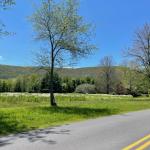
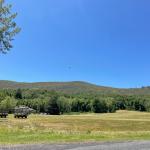
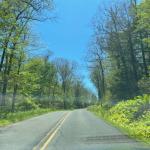 Spongy Moth: Lymantria dispar activity in parts of Berkshire County has been heightened this year. Many areas have experienced defoliation and large numbers of caterpillars. The good news is, spongy moth caterpillar activity for 2022 is soon coming to an end.
Spongy Moth: Lymantria dispar activity in parts of Berkshire County has been heightened this year. Many areas have experienced defoliation and large numbers of caterpillars. The good news is, spongy moth caterpillar activity for 2022 is soon coming to an end.
At this time of year, it is typical for spongy moth caterpillars to be nearing pupation, which luckily means that feeding for 2022 in western Massachusetts will be coming to an end. Pupation typically occurs by
the first two weeks in July, but may start in the last week of June. Recent reports indicate that caterpillars may be in different instars (sizes) at this time. This could be due to differences in location, but also due to parasitism by biological control enemies of the spongy moth. Hopefully at least some of those smaller-than-normal caterpillars will not survive to pupation.
Because most of the defoliation has been done at this point, and pupation is right around the corner, chemical management of these caterpillars may not help ornamental plants at this time in the season. Additionally, chemical management of larger spongy moth caterpillars (2-3 inches in length) can be very difficult.
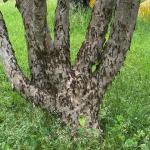
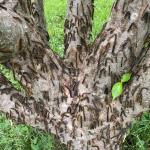
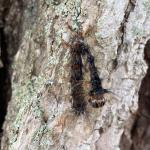 So in what can we hope? The good news: activity from the NPV virus and the spongy moth caterpillar killing fungus, Entomophaga maimaiga, has been reported in Berkshire County! Fungus and virus killed caterpillars have been reported in Williamstown, MA (6/21/2022) and Sheffield, MA (6/16/2022). Fungus-killed caterpillars will appear shriveled and dried, typically hanging vertically in a straight line on the trunks and branches of their hosts, or other surfaces nearby. Virus killed caterpillars tend to droop in an inverted-V shape and are often moist/juicy in appearance. The fungus and virus will hopefully help reduce the population of spongy moths in Berkshire County for next year – although time will tell. Continue to monitor for pupation and emerging adult male and female moths who will mate and begin laying their tan, spongy egg masses in July. Overwintering egg masses will provide the population for next year, if caterpillars survive to pupate into adults in 2022.
So in what can we hope? The good news: activity from the NPV virus and the spongy moth caterpillar killing fungus, Entomophaga maimaiga, has been reported in Berkshire County! Fungus and virus killed caterpillars have been reported in Williamstown, MA (6/21/2022) and Sheffield, MA (6/16/2022). Fungus-killed caterpillars will appear shriveled and dried, typically hanging vertically in a straight line on the trunks and branches of their hosts, or other surfaces nearby. Virus killed caterpillars tend to droop in an inverted-V shape and are often moist/juicy in appearance. The fungus and virus will hopefully help reduce the population of spongy moths in Berkshire County for next year – although time will tell. Continue to monitor for pupation and emerging adult male and female moths who will mate and begin laying their tan, spongy egg masses in July. Overwintering egg masses will provide the population for next year, if caterpillars survive to pupate into adults in 2022.
The bottom line: do not panic. The spongy moth (Lymantria dispar) has been in Massachusetts since the 1860’s and periodic outbreaks have occurred since then. Due to the fungus, virus, and other natural enemies, the populations will crash again.
Why did the common name for Lymantria dispar change recently? More information is available here: https://entsoc.org/news/press-releases/spongy-moth-approved-new-common-name-lymantria-dispar
To learn more about the life cycle and natural enemies of this insect, including the NPV virus and Entomophaga maimaiga,
visit: https://ag.umass.edu/landscape/education-events/insectxaminer.
-
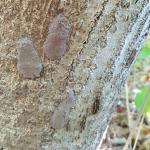 Spotted Lanternfly: (Lycorma delicatula, SLF) is a non-native, invasive insect that feeds on over 103 species of plants, including many trees and shrubs that are important in our landscapes.
Spotted Lanternfly: (Lycorma delicatula, SLF) is a non-native, invasive insect that feeds on over 103 species of plants, including many trees and shrubs that are important in our landscapes.
Currently, the only established populations of spotted lanternfly in Massachusetts are in a small area in both Fitchburg and Shrewsbury, MA. Therefore, there is no reason to be preemptively treating for this insect in other areas of Massachusetts. If you suspect you have found spotted lanternfly in additional locations, please report it immediately to MDAR here: https://massnrc.org/pests/slfreport.aspx . If you are living and working in the Fitchburg and Shrewsbury areas, please be vigilant and continue to report anything suspicious.
For More Information:
From UMass Extension:
Check out the InsectXaminer Episode about spotted lanternfly adults and egg masses! Available here: https://ag.umass.edu/landscape/education-events/insectxaminer
Fact Sheet: https://ag.umass.edu/landscape/fact-sheets/spotted-lanternfly
From the MA Department of Agricultural Resources:
Fact Sheet and Map of Locations in MA: https://massnrc.org/pests/pestFAQsheets/spottedlanternfly.html
-
Asian Longhorned Beetle: (Anoplophora glabripennis, ALB) Look for signs of an ALB infestation which include perfectly round exit holes (about the size of a dime), shallow oval or round scars in the bark where a female has chewed an egg site, or sawdust-like frass (excrement) on the ground nearby host trees or caught in between branches. Be advised that other, native insects may create perfectly round exit holes or sawdust-like frass, which can be confused with signs of ALB activity.
The regulated area for Asian longhorned beetle is 110 square miles encompassing Worcester, Shrewsbury, Boylston, West Boylston, and parts of Holden and Auburn. If you believe you have seen damage caused by this insect, such as exit holes or egg sites, on susceptible host trees like maple, please call the Asian Longhorned Beetle Eradication Program office in Worcester, MA at 508-852-8090 or toll free at 1-866-702-9938.
To report an Asian longhorned beetle find online or compare it to common insect look-alikes, visit: http://massnrc.org/pests/albreport.aspx or https://www.aphis.usda.gov/pests-diseases/alb/report .
-
Browntail Moth: Euproctis chrysorrhoea is an invasive insect originating from Europe and first detected in the US in Somerville, MA in 1897. Currently, browntail moth is limited to a small portion of eastern Massachusetts, particularly areas near the coast. Report suspected browntail moth life stages here: https://massnrc.org/pests/pestreports.htm . Due to a persistent outbreak of this insect in Maine since approximately 2016, it is a good idea for us to again familiarize ourselves with this pest. (For more information and the latest updates about the status of this insect in Maine, visit: https://www.maine.gov/dacf/mfs/forest_health/invasive_threats/browntail_moth_info.htm .)
Caution: hairs found on the caterpillar and pupal life stages of this insect can cause a rash similar to poison ivy. Some individuals are very sensitive to browntail moth hairs and may also experience allergic reaction. The chance of interacting with browntail moth hairs increases between May and July, although they could be a problem at any time of year.
The larval or caterpillar stage of this insect is present from August until the following June (spending the winter in webs they create on the tips of host plant twigs). In the fall, groups of caterpillars are found creating webs around a tightly wrapped leaf (covered in bright white silk) where they will overwinter in groups of 25-400. These 2-4 inch long webs can be found on the ends of branches often on apple or red oak. As soon as leaves begin to open in the spring (usually by April), the caterpillars will crawl from their webs to feed on the new leaves. Caterpillars are fully grown around June and spin cocoons in which they pupate. These cocoons are also full of the irritating hairs and should be dealt with extreme caution. Adult moths emerge in July and females lay eggs on the undersides of leaves in masses of 200-400, covering them with hairs from their bodies. (Adults do not typically cause skin rashes.) Eggs hatch around August and September and larvae feed shortly before forming their overwintering webs.
The primary concern with this insect are the poisonous hairs found on the caterpillars. Contact with the caterpillar or its hairs can cause a rash similar to poison ivy in susceptible individuals. If hairs break off and blow around in the wind, they can cause difficulty breathing and headaches. While this insect can act as a defoliator in the larval stage, feeding on the leaves of many deciduous trees and shrubs, this activity may be secondary to concerns about public health risks. Care should be taken to avoid places infested with these caterpillars, exposed skin or clothing should be washed, and the appropriate PPE should be worn if working with these insects. Consult your physician if you have a reaction to the browntail moth.
-
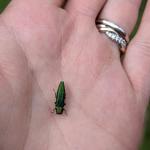 Emerald Ash Borer: (Agrilus planipennis, EAB) has been detected in at least 11 out of the 14 counties in Massachusetts. A map of these locations across the state may be found here: https://ag.umass.edu/fact-sheets/emerald-ash-borer . Additional information about this insect is provided by the MA Department of Conservation and Recreation, here:https://arcg.is/j8TiD .
Emerald Ash Borer: (Agrilus planipennis, EAB) has been detected in at least 11 out of the 14 counties in Massachusetts. A map of these locations across the state may be found here: https://ag.umass.edu/fact-sheets/emerald-ash-borer . Additional information about this insect is provided by the MA Department of Conservation and Recreation, here:https://arcg.is/j8TiD .
This wood-boring beetle readily attacks ash (Fraxinus spp.) including white, green, and black ash and has also been found developing in white fringe tree (Chionanthus virginicus) and has been reported in cultivated olive (Olea europaea). Signs of an EAB infested tree may include D-shaped exit holes in the bark (from adult emergence), “blonding” or lighter coloration of the ash bark from woodpecker feeding (chipping away of the bark as they search for larvae beneath), and serpentine galleries visible through splits in the bark, from larval feeding beneath. It is interesting to note that woodpeckers are capable of eating 30-95% of the emerald ash borer larvae found in a single tree (Murphy et al. 2018). Unfortunately, despite high predation rates, EAB populations continue to grow. However, there is hope that biological control efforts will eventually catch up with the emerald ash borer population and preserve some of our native ash tree species for the future. For an update about the progress of the biological control of emerald ash borer, visit Dr. Joseph Elkinton’s archived 2022 webinar
-
Jumping Worms: Amynthas spp. earthworms, collectively referred to as “jumping or crazy or snake” worms, overwinter as eggs in tiny, mustard-seed sized cocoons found in the soil or other substrate (ex. compost) that are impossible to remove. The first adults appear in the end of May – June, but the numbers are low and infestations are rarely noticed at that time. It is easy to misidentify earthworms if only immatures found. By August and September, this is when most observations of fully mature jumping worms occur. At that time, snake worms become quite abundant, infestations become very noticeable, and may cause a lot of concern for property owners and managers.
For More Information:
UMass Extension Fact Sheets:
Earthworms in Massachusetts – History, Concerns, and Benefits: https://ag.umass.edu/landscape/fact-sheets/earthworms-in-massachusetts-history-concerns-benefits
Jumping/Crazy/Snake Worms – Amynthas spp.:
https://ag.umass.edu/landscape/fact-sheets/jumpingcrazysnake-worms-amynthas-spp
A Summary of the Information Shared at UMass Extension’s Jumping Worm Conference in January 2022:
https://ag.umass.edu/news-events/highlights/jumping-worms-conference
Tree & Shrub Insect Pests, Continued:
-
Arborvitae Leafminer: In New England and eastern Canada, four species of leafminers are known to infest arborvitae. These include Argyresthia thuiella, A. freyella, A. aureoargentella, and Coleotechnites thujaella. The arborvitae leafminer, A. thuiella, is the most abundant of these and has the greatest known range when compared to the others. (It is also found in the Mid-Atlantic States and as far west as Missouri). Moths of this species appear from mid-June to mid-July and lay their eggs. The damage caused by all of these species is nearly identical. Trees, however, have been reported to lose up to 80% of their foliage due to arborvitae leafminer and still survive. At least 27 species of parasites have been reported as natural enemies of arborvitae leafminers, the most significant of which may be a parasitic wasp (Pentacnemus bucculatricis). Arborvitae leafminer damage causes the tips of shoots and foliage to turn yellow and brown. If infestations are light, prune out infested tips.
- Asiatic Garden Beetle: Maladera castanea adults are active and are typically most abundant in July and August. These rusty-red colored beetles are bullet-shaped and active at night. They are often attracted to porch lights. They feed on a number of ornamental plants, defoliating leaves by giving the edges a ragged appearance and also feeding on blossoms. Butterfly bush, rose, dahlia, aster, and chrysanthemum can be favored hosts.
- Azalea Bark Scale: Eriococcus azaleae was discovered in CT in 1917 and has since been reported in other states. It is found on the bark of twigs and stems and commonly settles in branch crotches. It has been reported on azalea, rhododendron, andromeda, and others. Female scales are approximately 2-3 mm. in length and covered in a white, waxy coating. The females are purple in color and may resemble a mealybug, although they are a soft or felt scale. Females overwinter and lay eggs which will hatch into crawlers toward the end of June through mid-July. Crawlers will settle into branch crotches, bark crevices, or on the axils of leaves. There is a parasitic wasp that will attack these insects. When high in number, these scales can cause yellowing of the foliage and their sugary excrement can lead to the promotion of sooty mold. Because these are soft scales, they may be targeted with horticultural oils or insecticidal soaps while observing label instructions to prevent phytotoxicity.
-
Azalea Sawflies: There are a few species of sawflies that impact azaleas. Johnson and Lyon's Insects that Feed on Trees and Shrubs mentions three of them. Amauronematus azaleae was first reported in New Hampshire in 1895 and is likely found in most of New England. Adults of this species are black with some white markings and wasp-like. Generally green larvae feed mostly on mollis hybrid azaleas. Remember, sawfly caterpillars have at least enough abdominal prolegs to spell “sawfly” (so 6 or more prolegs). Adults are present in May, and females lay their eggs and then larvae hatch and feed through the end of June. There is one generation per year. Nematus lipovskyi has been reared from swamp azalea (Rhododendron viscosum). Adults of that species have been collected in April (in states to the south) and May (in New England) and larval feeding is predominantly in late April and May in Virginia and June in New England. One generation of this species occurs per year, and most mollis hybrid azaleas can be impacted. A third species, Arge clavicornis, is found as an adult in July and lays its eggs in leaf edges in rows. Larvae are present in August and September. Remember, Bacillus thuringiensis Kurstaki does not manage sawflies.
-
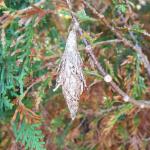 Bagworm: Thyridopteryx ephemeraeformis is a native species of moth whose larvae construct bag-like coverings over themselves with host plant leaves and twigs. Look for caterpillars with cone-like coverings of chewed up leaves, bark, and other plant parts. Common bagworm may be found on evergreen and deciduous host plants. More information can be found here: https://ag.umass.edu/landscape/fact-sheets/bagworm .
Bagworm: Thyridopteryx ephemeraeformis is a native species of moth whose larvae construct bag-like coverings over themselves with host plant leaves and twigs. Look for caterpillars with cone-like coverings of chewed up leaves, bark, and other plant parts. Common bagworm may be found on evergreen and deciduous host plants. More information can be found here: https://ag.umass.edu/landscape/fact-sheets/bagworm . - Cottony Taxus Scale: Pulvinaria floccifera, also referred to as the cottony camellia scale, utilizes such hosts as taxus, camellia, holly, hydrangea, Japanese maple, euonymus, magnolia, and jasmine, among others. Females have laid the long, narrow, white and fluted egg sac that makes them much more noticeable. Eggs will hatch over an extended period of 6 weeks and crawlers may be treated between 802-1388 GDD’s. This insect can cause the host to appear off-color. They also produce honeydew which promotes sooty mold growth. Dieback is not common with this insect. Target the underside of the foliage. Horticultural oil, neem oil, and insecticidal soaps may be used to manage these soft scales. Reduced risk options help preserve natural enemies.
-
Dogwood Borer: Synanthedon scitula is a species of clearwing moth whose larvae bore not only into dogwood (Cornus), but hosts also include flowering cherry, chestnut, apple, mountain ash, hickory, pecan, willow, birch, bayberry, oak, hazel, myrtle, and others. Kousa dogwood appear to be resistant to this species. Signs include the sloughing of loose bark, brown frass, particularly near bark cracks and wounds, dead branches, and adventitious growth. The timing of adult emergence can be expected when dogwood flower petals are dropping and weigela begins to bloom. Adult moth flights continue from then until September. Emergence in some hosts (ex. apple) appears to be delayed, but this differs depending upon the location in this insect’s range. Eggs are laid singly, or in small groups, on smooth and rough bark. Female moths preferentially lay eggs near wounded bark. After hatch, larvae wander until they find a suitable entrance point into the bark. This includes wounds, scars, or branch crotches. This insect may also be found in twig galls caused by other insects or fungi. Larvae feed on phloem and cambium. Fully grown larvae are white with a light brown head and are approx. ½ inch long. Pheromone traps and lures are useful for determining the timing of adult moth emergence and subsequent management.
-
Dogwood Sawfly: Macremphytus tarsatus has one generation per year. The larvae of the dogwood sawfly overwinter in decaying wood and occasionally compromised structural timber. An overwintering "cell" is created in this soft wood. Pupation occurs in the springtime and adults can take a lengthy time to emerge, roughly between late May and July. 100+ eggs are laid in groups on the underside of leaves. Eggs hatch and the larvae feed gregariously, initially skeletonizing leaves. As the caterpillars grow in size, they are capable of eating the entire leaf with the exception of the midvein. Larval appearance varies greatly throughout instars, so much so that one might mistake them for multiple species. Early instars are translucent and yellow, but as the caterpillars grow they develop black spots (over yellow) and become covered in a white powder-like material. Larvae and their shed skins may resemble bird droppings. Full grown larvae begin to wander in search of a suitable overwintering location. Rotting wood lying on the ground is preferred for this. Foliage of dogwood, especially gray dogwood (Cornus racemosa) may be impacted. Skeletonizes leaves at first, then eats all but the midvein.
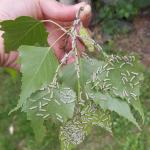 Fall Webworm: Hyphantria cunea is native to North America and Mexico. It is now considered a world-wide pest, as it has spread throughout much of Europe and Asia. (For example, it was introduced accidentally into Hungary from North America in the 1940’s.) Hosts include nearly all shade, fruit, and ornamental trees except conifers. In the USA, at least 88 species of trees are hosts for these insects, while in Europe at least 230 species are impacted. In the past history of this pest, it was once thought that the fall webworm was a two-species complex. It is now thought that H. cunea has two color morphs – one black headed and one red headed. These two color forms differ not only in the coloration of the caterpillars and the adults, but also in their behaviors. Caterpillars may go through at least 11 molts, each stage occurring within a silken web they produce over the host. When alarmed, all caterpillars in the group will move in unison in jerking motions that may be a mechanism for self-defense. Depending upon the location and climate, 1-4 generations of fall webworm can occur per year. Fall webworm adult moths lay eggs on the underside of the leaves of host plants in the spring. These eggs hatch in late June or early July depending on climate. Young larvae feed together in groups on the undersides of leaves, first skeletonizing the leaf and then enveloping other leaves and eventually entire branches within their webs. Tiny, early instar (black-headed) fall webworm caterpillars were observed feeding on birch in Hampshire County, MA on 7/5/2022. At this size, caterpillars skeletonize the leaves as they feed. Webs are typically found on the terminal ends of branches. All caterpillar activity occurs within this tent, which becomes filled with leaf fragments, cast skins, and frass. Fully grown larvae then wander from the webs and pupate in protected areas such as the leaf litter where they will remain for the winter. Adult fall webworm moths emerge the following spring/early summer to start the cycle over again. 50+ species of parasites and 36+ species of predators are known to attack fall webworm in North America. Fall webworms typically do not cause extensive damage to their hosts. Nests may be an aesthetic issue for some. If in reach, small fall webworm webs may be pruned out of trees and shrubs and destroyed. Do not set fire to H. cunea webs when they are still attached to the host plant.
Fall Webworm: Hyphantria cunea is native to North America and Mexico. It is now considered a world-wide pest, as it has spread throughout much of Europe and Asia. (For example, it was introduced accidentally into Hungary from North America in the 1940’s.) Hosts include nearly all shade, fruit, and ornamental trees except conifers. In the USA, at least 88 species of trees are hosts for these insects, while in Europe at least 230 species are impacted. In the past history of this pest, it was once thought that the fall webworm was a two-species complex. It is now thought that H. cunea has two color morphs – one black headed and one red headed. These two color forms differ not only in the coloration of the caterpillars and the adults, but also in their behaviors. Caterpillars may go through at least 11 molts, each stage occurring within a silken web they produce over the host. When alarmed, all caterpillars in the group will move in unison in jerking motions that may be a mechanism for self-defense. Depending upon the location and climate, 1-4 generations of fall webworm can occur per year. Fall webworm adult moths lay eggs on the underside of the leaves of host plants in the spring. These eggs hatch in late June or early July depending on climate. Young larvae feed together in groups on the undersides of leaves, first skeletonizing the leaf and then enveloping other leaves and eventually entire branches within their webs. Tiny, early instar (black-headed) fall webworm caterpillars were observed feeding on birch in Hampshire County, MA on 7/5/2022. At this size, caterpillars skeletonize the leaves as they feed. Webs are typically found on the terminal ends of branches. All caterpillar activity occurs within this tent, which becomes filled with leaf fragments, cast skins, and frass. Fully grown larvae then wander from the webs and pupate in protected areas such as the leaf litter where they will remain for the winter. Adult fall webworm moths emerge the following spring/early summer to start the cycle over again. 50+ species of parasites and 36+ species of predators are known to attack fall webworm in North America. Fall webworms typically do not cause extensive damage to their hosts. Nests may be an aesthetic issue for some. If in reach, small fall webworm webs may be pruned out of trees and shrubs and destroyed. Do not set fire to H. cunea webs when they are still attached to the host plant.- Hibiscus Sawfly: The larvae of the hibiscus (mallow) sawfly, likely Atomacera decepta, may be observed feeding on hibiscus hosts at this time. Sawfly larvae develop into wasp-like adults (Order: Hymenoptera) and therefore these “caterpillars” will not be managed by Bacillus thuringiensis var. kurstaki which is specific to the Lepidoptera (caterpillars that develop into moths or butterflies as adults). Reduced risk active ingredients such as spinosad are labeled for use against sawfly larvae. However, given that hibiscus are very attractive to pollinators, non-chemical management options such as hand picking and disposing of larvae, when possible, are best. Spinosad is toxic to pollinators until it dries. For more information about the risks of insecticide active ingredients to pollinators, visit: https://ag.umass.edu/landscape/fact-sheets/tree-shrub-insecticide-active-ingredients-risks-to-pollinators-other-non .
The hibiscus (mallow) sawfly adult female uses her ovipositor to cut slits into leaf surfaces to deposit her eggs. Larvae emerge from these eggs and begin by first feeding on leaf undersides when small, and then move to feed on leaf surfaces as they grow in size. Only large leaf veins may be left behind if the population is large enough. Larvae have been observed moving to the base of the plant to pupate. Adults emerge and in some locations in the US, multiple generations have been recorded per year. This insect is known in the mid-Atlantic and Midwest states, but was reported feeding on Hibiscus spp. in Connecticut in 2004 and 2005 and has previously been reported in Massachusetts. The timing of the life cycle of this insect, as well as how many generations occur per year in Massachusetts, however, is not fully understood. Some research has shown that Hibiscus acetosella, H. aculeatus, and H. grandiflora seem to either exhibit some resistance to or tolerance of hibiscus sawfly feeding. In one study, all three had few if any eggs or larvae and were given the lowest damage rating among the species evaluated. This insect also does not feed on rose of Sharon or H. rosasinensis. It has, however, been reported to “voraciously” feed on H. moscheutos, H. palustris, H. militaris, and H. lasiocarpus.
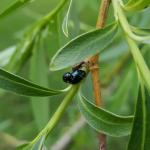 Imported Willow Leaf Beetle: Plagiodera versicolora adult beetles overwinter near susceptible hosts. Adult beetles will chew holes and notches in the leaves of willow once they become available. Females lay yellow eggs in clusters on the undersides of leaves. Larvae are slug-like and bluish-green in color. They will feed in clusters and skeletonize the leaves. Most plants can tolerate multiple years of feeding from this insect, and foliage will appear brown. Repeated yearly feeding can occasionally be an issue, in which case management of the young larvae may be necessary. Take care with treatment in areas near water. Check out Episode 4 of InsectXaminer to see the imported willow leaf beetle in action: https://ag.umass.edu/landscape/education-events/insectxaminer
Imported Willow Leaf Beetle: Plagiodera versicolora adult beetles overwinter near susceptible hosts. Adult beetles will chew holes and notches in the leaves of willow once they become available. Females lay yellow eggs in clusters on the undersides of leaves. Larvae are slug-like and bluish-green in color. They will feed in clusters and skeletonize the leaves. Most plants can tolerate multiple years of feeding from this insect, and foliage will appear brown. Repeated yearly feeding can occasionally be an issue, in which case management of the young larvae may be necessary. Take care with treatment in areas near water. Check out Episode 4 of InsectXaminer to see the imported willow leaf beetle in action: https://ag.umass.edu/landscape/education-events/insectxaminer- Japanese Beetles: Popillia japonica adult beetles are active. Adult female beetles will lay their eggs primarily by early August, however eggs may be laid into September. Females lay these eggs in groups in soil cavities they excavate 2-4 inches down. Japanese beetles overwinter as nearly grown grubs in the soil which are capable of evading freezing behaviorally by moving below the frost line. As soils warm in the spring, larvae become active and feed on the roots of grasses. Pupation occurs 1-3 feet below the soil surface. Adults emerge from these lawn areas and disperse to feed on foliage, mate, and return to turf-type locations for females to lay their eggs. Japanese beetle adults use aggregation pheromones (chemicals that signal between individuals) to call in others of the same species. These pheromones and volatile chemicals from host plants being fed upon are thought to be the reason why large numbers of these beetles can be found feeding together. Adult beetles feed on foliage and flowers, often skeletonizing leaves until they appear lace-like. Larvae are highly damaging turf pests. Tree and shrub hosts are comprised of more than 300 species including but not limited to rose, mountain-ash, willow, linden, elm, Japanese and Norway maples, birch, sycamore, rose of Sharon, ornamental apple, and many others. Adult beetles are often attracted to feeding on sunny areas of the plant. Many organisms are parasitoids of Japanese beetles, such as two wasps that attack overwintered grubs in the spring, and a tachinid fly (winsome fly: Istocheta aldrichi) which parasitizes newly emerged adult beetles. Other organisms act as generalist predators with Japanese beetles on their menus, including but not limited to ants, certain other beetles, small mammals, and birds.
- Lacebugs: Stephanitis spp. lacebugs such as S. pyriodes can cause severe injury to azalea foliage. S. rhododendri can be common on rhododendron and mountain laurel. S. takeyai has been found developing on Japanese andromeda, leucothoe, styrax, and willow. Stephanitis spp. lace bug activity should be monitored through September. Before populations become too large, treat with a summer rate horticultural oil spray as needed. Be sure to target the undersides of the foliage in order to get proper coverage of the insects. Certain azalea and andromeda cultivars may be less preferred by lace bugs.
-
Lilac Borer: Podosesia syringae is a clearwing moth pest of lilac, privet, fringetree, and ash. (It is also known as the ash borer, not to be confused with the emerald ash borer.) Adults mimic paper wasps. Larvae are wood-boring, and signs and symptoms include branch dieback, holes, and occasionally, sawdust-like frass accumulated on bark. Larvae bore into stems, trunks, and branches, chewing an irregularly shaped entrance hole. Peak adult moth flights may occur in the northern portion of this insect’s range in June and are usually over by August 1st. Pheromone traps can be used to time adult emergence. Adult females lay flattened, oval, and tan eggs that are deposited singly or in clusters on bark crevices, ridges, and sometimes smooth bark; but usually laid in or near wounds in the bark. On average, 395 eggs are laid by each female. After hatch, larvae chew into the bark and feed laterally and then vertically in phloem tissue. Larvae overwinter in tunnels in the final instar and resume feeding in the spring. Adults emerge through a round exit hole (4-5 mm. in diameter). This insect may be targeted between 200-299 GDD’s, base 50°F.
-
Magnolia Scale: Neolecanium cornuparvum overwinters as first instar nymphs which are elliptical, and dark slate gray in color and can usually be found on the undersides of 1 and 2 year old twigs. Nymphs may molt by late April or May and again by early June at which time the scales may be purple in color. Eventually nymphs secrete a white powdery layer of wax over their bodies.
-
Taxus Mealybug: Dysmicoccus wistariae will produce honeydew and lead to sooty mold growth, yellowing of needles, and sparsely foliated plants. Eventual dieback may be possible. This species is commonly associated with taxus in New England, but can be occasionally found on dogwood, rhododendron, Prunus spp., maple, andromeda, and crabapple. These mealybugs are found on stems and branches and particularly like to congregate at branch crotches. Taxus mealybug feeds in the inner bark tissue of the trunk and branches. Adult females are present from June to August and give birth to living young in the summer. Immatures overwinter. A single generation may occur per year in New England, but areas to the south can have multiple generations of this insect. Management may be targeted between 246-618 GDD’s, base 50°F. Horticultural oil and neem oil may be used.
- Two-Spotted Spider Mite: Tetranychus urticae is a “warm-season” mite that loves hot and dry weather, which may favor the quick reproduction and build-up of this pest. Management should seek to preserve beneficial predatory mites. Monitor susceptible hosts (elm, maple, redbud, ash, black locust, tuliptree, and many deciduous shrubs) for increasing numbers of these mites until mid-August. Mites will be found on the undersides of leaves and cause stippling of the foliage.
-
Viburnum Leaf Beetle: Pyrrhalta viburni is a beetle in the family Chrysomelidae that is native to Europe, but was found in Massachusetts in 2004. This beetle feeds exclusively on many different species of viburnum, which includes, but is not limited to, susceptible plants such as V. dentatum, V. nudum, V. opulus, V. propinquum, and V. rafinesquianum. Adult beetles emerge following pupation in early July. At this time, adult beetles will resume feeding, mate, and the females will lay their eggs in pits they chew at the ends of twigs. Eggs overwinter. Adults may also migrate to previously not yet infested plants. Adult viburnum leaf beetle feeding appears different from that of the larvae. Adults chew oblong holes in leaves. Some viburnum have been observed to have varying levels of resistance to this insect, including but not limited to V. bodnantense, V. carlesii, V. davidii, V. plicatum, V. rhytidophyllum, V. setigerum, and V. sieboldii. More information about viburnum leaf beetle may be found at http://www.hort.cornell.edu/vlb/ .
-
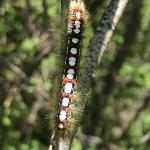
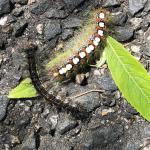 White Satin Moth: Leucoma salicis has again been reported from Beartown State Forest (Berkshire County) on 6/8/2022 by the Massachusetts Department of Conservation and Recreation, Forest Health Program (photos courtesy of Eric Reynolds). This is the same location that caterpillars of this species were seen defoliating their hosts in 2020 and 2021.
White Satin Moth: Leucoma salicis has again been reported from Beartown State Forest (Berkshire County) on 6/8/2022 by the Massachusetts Department of Conservation and Recreation, Forest Health Program (photos courtesy of Eric Reynolds). This is the same location that caterpillars of this species were seen defoliating their hosts in 2020 and 2021.
The caterpillars of this species have a unique color pattern, which helps us distinguish them from others. The dorsal (back) side of the caterpillar is marked with 10-11 white, intersegmental spots as well as paired, red “setal warts”. The sides of the caterpillars are blueish gray. These caterpillars are known to the edges of waterways, woodlands, and forests from Canada to northwestern Connecticut and central New York. One generation occurs per year with mature caterpillars known in May and June. Host plants include aspen, poplar, and willow, the leaves of which are fed upon by the caterpillars of this species.
The white satin moth was introduced from Europe and first reported between Boston, MA and Hampton, New Hampshire in 1920. This insect is said to overwinter in the third instar (caterpillars pass through seven instars), either individually or in small groups. In the springtime, caterpillars leave their areas of hibernation to feed on nearby leaves. Caterpillars spin a thin cocoon between leaves or between exfoliating or thick bark crevices. Pupae are dark brown/black and often in a thin, loose silken sack. Pupae also sport brightly colored, yellow setae (hairs) that make them quite attractive. Pupation begins by the end of June. Shortly thereafter, moths emerge and females lay egg masses covered in a frothy, white material from July – mid-August. Eggs hatch sometime in August, and larvae will conduct feeding in August and September.
While caterpillars of this species are not noted to be of particular concern with regard to causing allergic reactions such as dermatitis, they are a type of tussock moth and do possess hairs, so they should not be handled and should be approached with caution particularly by sensitive individuals.
Concerned that you may have found an invasive insect or suspicious damage caused by one? Need to report a pest sighting? If so, please visit the Massachusetts Introduced Pests Outreach Project: http://massnrc.org/pests/pestreports.htm .
Reported by Tawny Simisky, Extension Entomologist, UMass Extension Landscape, Nursery, & Urban Forestry Program
Weeds
Treat garlic mustard, Alliaria petiolata, now. Second year plants are already in fruit and seed heads should be removed if possible. Garlic mustard is a biennial and herbicide applications at this time of year will control first-year plants. Controlling first-year plants will eliminate them so they are not there to flower and produce seed next year.
New growth expansion of poison ivy continues. Poison ivy is flowering and just past flowering so now is the perfect time to start treatment. Glyphosate or triclopyr are the best herbicides for poison ivy control and applications can be done from now until mid-September. Triclopyr products should be selected over glyphosate products in areas where grasses need to be saved. Contact (Scythe, Reward) or the non-chemical/organic herbicide products will provide “burndown” activity only and will not adequately control poison ivy.
Scout for annual weeds in ornamental beds. If a preemergence herbicide was applied earlier in the season now would be a good time to begin determining if the application provided effective control. Treat these weeds before they get too large. Spot spraying with a non-selective herbicide is usually a better strategy than hand-weeding because it does not break the mulch barrier.
Scout for weeds that may be creeping into beds from adjacent turf areas. Use a non-selective herbicide to edge the bed.
Tree seedlings are continuing to germinate, and some locations may have seedlings that are 2 to 3 inches tall. These seedlings can be treated with pelargonic acid, Scythe. Another option would be to cut these seedlings with a gas, electric or battery powered hedge shear at the soil or mulch surface. The organic/non-chemical products do not translocate and will not provide effective control of these young tree seedlings. Tree seedlings in turf areas will be controlled with mowing and an herbicide application is not necessary.
Reported by Randy Prostak, Weed Specialist, UMass Extension Landscape, Nursery and Urban Forestry Program
Additional Resources
Pesticide License Exams - The MA Dept. of Agricultural Resources (MDAR) is now holding exams online. For more information and how to register, go to: https://www.mass.gov/pesticide-examination-and-licensing.
To receive immediate notification when the next Landscape Message update is posted, join our e-mail list or follow us on Facebook.
For a complete listing of upcoming events, see our upcoming educational events https://ag.umass.edu/landscape/upcoming-events
For commercial growers of greenhouse crops and flowers - Check out UMass Extension's Greenhouse Update website
For professional turf managers - Check out Turf Management Updates
For home gardeners and garden retailers - Check out our home lawn and garden resources.
Diagnostic Services
UMass Laboratory Diagnoses Landscape and Turf Problems - The UMass Extension Plant Diagnostic Lab is available to serve commercial landscape contractors, turf managers, arborists, nurseries and other green industry professionals. It provides woody plant and turf disease analysis, woody plant and turf insect identification, turfgrass identification, weed identification, and offers a report of pest management strategies that are research based, economically sound and environmentally appropriate for the situation. Accurate diagnosis for a turf or landscape problem can often eliminate or reduce the need for pesticide use. For sampling procedures, detailed submission instructions and a list of fees, see Plant Diagnostic Laboratory
Soil and Plant Nutrient Testing - The University of Massachusetts Soil and Plant Nutrient Testing Laboratory is located on the campus of The University of Massachusetts at Amherst. Testing services are available to all. The lab provides test results and recommendations that lead to the wise and economical use of soils and soil amendments. For more information, including current turn-around times, visit the UMass Soil and Plant Nutrient Testing Laboratory web site. The lab is currently accepting new orders for Routine Soil Analysis (including optional Organic Matter, Soluble Salts, and Nitrate testing), Particle Size Analysis, Pre-Sidedress Nitrate (PSNT), and Soilless Media (no other types of soil analyses available at this time). Turnaround time: Please plan for the fact that date of receipt in the lab is affected by weekends, holidays, shipping time, and time for UMass Campus Mail to deliver samples to the lab.
Tick Testing - The UMass Center for Agriculture, Food, and the Environment provides a list of potential tick identification and testing options at: https://ag.umass.edu/resources/tick-testing-resources.
Acknowledgements: UMass Extension gratefully acknowledges the support of the following funding sources for the production of the Landscape Message –
- The Massachusetts Nursery and Landscape Association Fund
- The Massachusetts Department of Conservation and Recreation, Award #ISADCR28219926UMA22A
- Stakeholders like you! The Landscape Message is partially supported by educational program user fees.